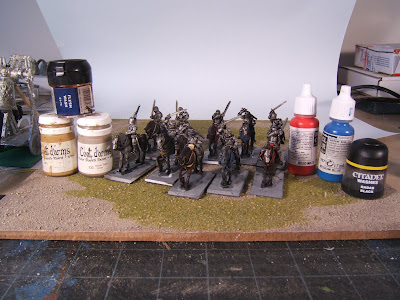This is a bit of a quickie project. It's part of my experiments with "dipping." I've posted a bit abour my first experiment at my regular blog.
As a "quickie" (and since I am very short of time these days) I don't have a step by step set of photos, but since I was painting in flat colors, I don't think that matters as much as with the (mainly) layering & wash process I normally use.
Apologizes for the poor photos, the only camera I had on me was my phone. I will take better photos of the completed figures, after spraying a matte finish, in the next few days.
The figures are 16 Cretan Archers from Black Tree Design. I am painting them now because of the Macedonian/Successor project I am finally working on. But they will see use in other roles and appropriate periods as well. They're nice, cleanly sculpted and cast figures (though there are pronounced mould lines on the hats) and should be simple to work on.
So here is the first photo, showing the first six steps. All done in flat colors.

Step One: Paint flesh. 15 min.
Step Two: Paint beards & hats. 12 min.
Step Three. Paint tunics. 28 min.
Step Four. Paint leather/quiver. 10 min.
Step Five. Paint bows. 6 min.
Step Six. Paint arrow flights. 4 min.
So that's a total of 75 minutes so far, or a little under 5 minutes per figure.
Now for the second phase of painting, and a bit more experimenting.

These were all hit with the big "dip" wash. I brush it all on, I don't actually dip the figures as some people apparently do. But in this case I tried two different washes.
On the left are 8 figures washed with the usual Minwax Antique Walnut. On the right are 8 figures washed with my own "Substance D" recipe of Future, anti-shine medium, a bit of water and some Ceramcoat Dark Burnt Umber.
Each set of 8 figures took 6 minutes of brushing, plus a little bit of dabbing off of the pooled wash in places. (I did miss a few pooled spots!) So that brings the time up to...,
Total Time: 87 min.
That's just under 5.5 min. per figure! Certainly beats the 17-21 min. per figure rate for some of the previous infantry, and even the 12 min. per figure of the simple knights. Admittedly, these were also very simple figures Although I loved the way these washes turned out on the Carthaginians on which I previously experimented, I'm still not convinced of how well they work on figures with large flowing drapery, as these have. I will see how they look after they dry overnight and get a matte varnish, though.
Previous blog entries:
http://zerotwentythree.blogspot.com/2011/04/taking-plunge-with-dipping.html
http://zerotwentythree.blogspot.com/2011/04/dipping-experiment-continued.html



























